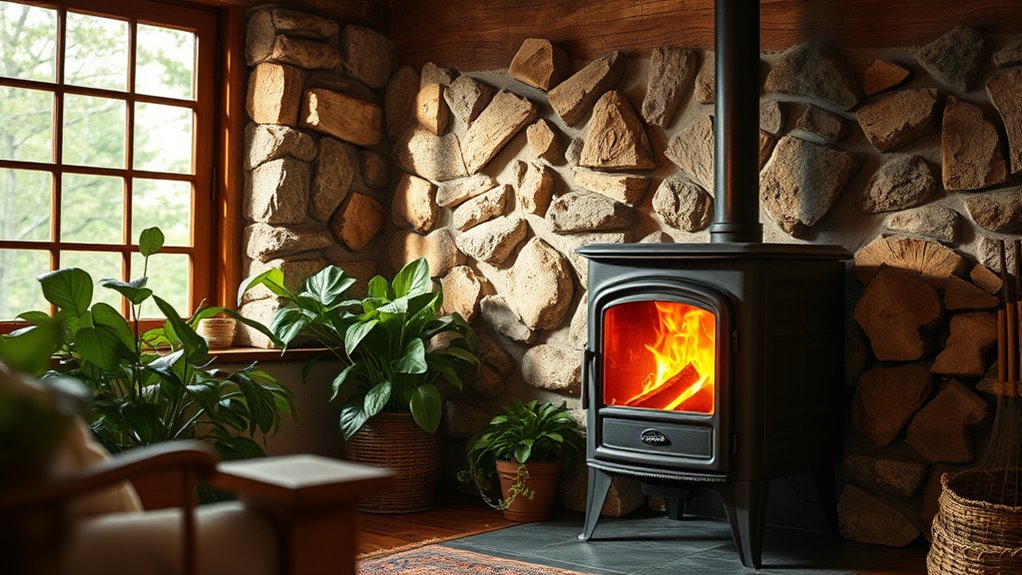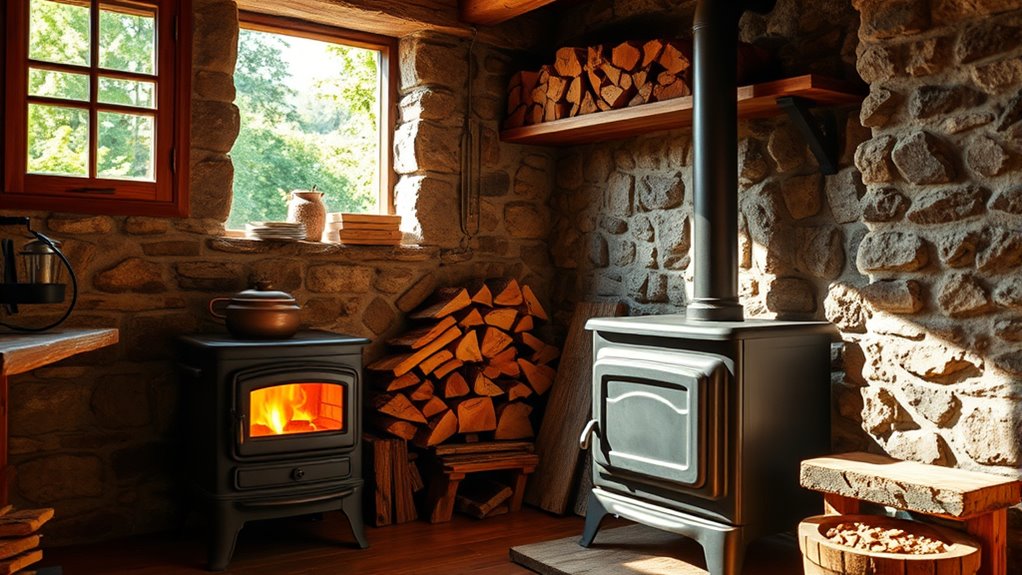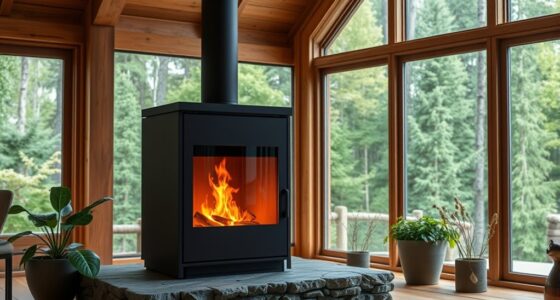Yes, wood stoves can be part of a sustainable energy mix if you use responsibly harvested and seasoned wood, coupled with modern, efficient designs that reduce emissions. Proper maintenance and good burning practices also help minimize environmental impacts. When integrated with other renewable sources, like solar or heat pumps, wood stoves can provide reliable, low-carbon heating. To learn how to make your wood stove truly sustainable, consider what best practices can enhance its role in the overall energy plan.
Key Takeaways
- Modern, EPA-certified wood stoves burn more efficiently and emit fewer pollutants, supporting cleaner energy use.
- When sustainably harvested and properly maintained, wood can be a renewable and carbon-neutral heating option.
- Wood stoves can complement other renewable sources, forming a diversified, resilient energy mix.
- Responsible harvesting and replanting practices ensure the long-term sustainability of wood as an energy resource.
- Incorporating wood stoves into a broader renewable strategy reduces reliance on fossil fuels and lowers overall carbon footprint.

Have you ever wondered if wood stoves can be a sustainable energy solution? It’s a common question as more people look for eco-friendly ways to heat their homes. The idea of using wood, a natural and renewable resource, appeals because it can provide reliable warmth while potentially reducing reliance on fossil fuels. However, to determine if wood stoves truly fit into a sustainable energy mix, you need to consider their impact on carbon emissions and how they compare to other renewable heating options.
Considering wood stoves as a sustainable heating option involves evaluating their carbon impact and how they compare to other renewables.
When you burn wood, it releases carbon dioxide into the atmosphere. At first glance, this might seem like a setback for sustainability. But, wood is considered a renewable energy source because trees absorb CO2 as they grow. If you harvest wood responsibly—meaning replant trees at a rate equal to or greater than your usage—the overall carbon emissions from burning wood can be nearly neutral over time. This cycle makes wood stoves a potentially sustainable form of heating, especially when compared to fossil fuels that release carbon stored underground for millions of years.
That said, not all wood stoves are created equal. Modern, EPA-certified stoves burn wood more completely and efficiently, considerably reducing emissions and particulate matter. This means you can enjoy the warmth without contributing as much to local air pollution or excess carbon emissions. Choosing the right stove, paired with properly seasoned wood, ensures you use energy efficiently and minimize your environmental footprint.
In the context of renewable heating, wood stoves can be a useful component, especially in rural areas where access to other renewable energy sources like solar or geothermal might be limited. They provide reliable heat during cold months and can lessen your dependence on non-renewable options. Still, they should be part of a broader, integrated approach to sustainable energy. Combining wood with other renewable options like solar panels or heat pumps enhances overall efficiency and reduces environmental impact.
While wood stoves can contribute to a sustainable energy mix, your choices matter. Using responsibly sourced, seasoned wood, maintaining your stove properly, and ensuring good combustion practices are essential. This way, you can enjoy the comfort of a warm home while supporting the reduction of carbon emissions. Incorporating modern technology and responsible harvesting practices can significantly improve their sustainability. In the end, wood stoves can be part of a sustainable solution if you prioritize responsible harvesting, modern technology, and integrate them with other renewable heating methods.
Frequently Asked Questions
How Do Wood Stoves Compare to Solar Panels in Sustainability?
Wood stoves are less sustainable than solar panels because they can emit carbon and aren’t as energy efficient. While wood stoves might achieve some level of carbon neutrality if sourced responsibly, solar panels produce clean energy with no emissions. You benefit from greater energy efficiency with solar, reducing your carbon footprint more effectively. Overall, solar panels are a more sustainable choice for long-term environmental impact.
What Are the Latest Innovations in Eco-Friendly Wood Stove Technology?
Imagine a wood stove that’s as sleek as a smartphone—today’s eco-friendly models use advanced biomass combustion to maximize efficiency. Innovations like catalytic converters and airwash systems markedly reduce emissions, making them cleaner than ever. For example, some stoves achieve up to 90% emission reduction, turning the traditional wood burner into a sustainable choice. These advancements help you enjoy warmth while minimizing environmental impact, truly modernizing biomass combustion.
Can Wood Stoves Reduce Overall Household Carbon Footprint?
Yes, wood stoves can reduce your household carbon footprint if they’re energy efficient and use sustainable wood sources. Modern designs burn wood more completely, releasing less pollution and capturing more heat, which lowers your overall emissions. By choosing eco-friendly, efficient models, you can heat your home sustainably while minimizing environmental impact, helping you contribute to a cleaner, greener future.
How Do Local Regulations Impact the Use of Wood Stoves?
Local regulations substantially impact your use of wood stoves. Urban restrictions may limit or ban their installation to reduce air pollution, while emission standards require you to choose models that produce fewer pollutants. You need to stay informed about these rules, as non-compliance could lead to fines or the need to upgrade your stove. By following local regulations, you help protect air quality and ensure your stove remains a sustainable and legal part of your home.
Are There Certified Sustainable Sources for Firewood?
Sure, there are certified sustainable sources for firewood, but don’t fall for the illusion of eco-friendly sourcing. Look for labels like FSC or PEFC, which guarantee sustainable certification. It’s like choosing organic vegetables—great in theory, but often more about marketing than actual eco-friendliness. So, if you want truly sustainable firewood, do your homework and support suppliers committed to responsible harvesting practices.
Conclusion
Think of your energy choices as a garden—you need a mix of plants to thrive. Wood stoves can be part of that garden if used responsibly, like nurturing a resilient plant. They offer warmth and comfort, but they shouldn’t be the entire landscape. By balancing wood with other renewable sources, you create a sustainable mosaic that’s resilient and vibrant. Embrace this diversity, and your energy future becomes a thriving, harmonious ecosystem.











